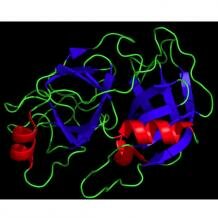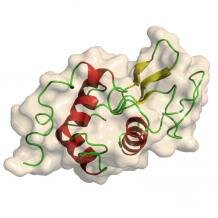Topic: Enzymes: convergence on active sites and reaction types
Enzymes make the world go round, each an evolutionary marvel - and convergent.
Until quite recently it was thought that evolutionary convergence amongst enzymes would be uncommon, but it is now clear that there are hundreds of examples in the various classes of enzyme that play key roles in biochemistry and metabolism.  Enzymes are nature’s catalysts, proteins that selectively bind to a substrate and convert it into several products. By lowering the activation energy, enzymes greatly accelerate chemical reactions at ordinary temperatures and pressures, in a way that would be the envy of any chemical engineer. This degree of acceleration does vary, from the “impossibly fast” carbonic anhydrase (an enzyme that converts carbon dioxide and water to bicarbonate and protons and is thus essential for the removal of carbon dioxide and the acid-base balance in the body) to the remarkably inefficient photosynthetic RuBisCo. RuBisCo is involved in carbon fixation and inefficient because the inevitable by-product of the reaction it catalyses is oxygen, which interferes with the catalytic process.
Enzymes are nature’s catalysts, proteins that selectively bind to a substrate and convert it into several products. By lowering the activation energy, enzymes greatly accelerate chemical reactions at ordinary temperatures and pressures, in a way that would be the envy of any chemical engineer. This degree of acceleration does vary, from the “impossibly fast” carbonic anhydrase (an enzyme that converts carbon dioxide and water to bicarbonate and protons and is thus essential for the removal of carbon dioxide and the acid-base balance in the body) to the remarkably inefficient photosynthetic RuBisCo. RuBisCo is involved in carbon fixation and inefficient because the inevitable by-product of the reaction it catalyses is oxygen, which interferes with the catalytic process.
Types of enzymatic convergence
There are two rather different ways in which enzymatic convergence can be addressed, which may be referred to as mechanistic and transformational. Not infrequently, however, there is an overlap so that convergence occurs in the same enzyme in both ways.
Mechanistic convergence
Mechanistic convergence is exemplified by the repeated evolution of the same active (or catalytic) site. The active site, the part where the substrate binds and is converted, typically consists of an association of specific amino acids and sometimes a metal such as zinc, iron, molybdenum or selenium. The classic example is the well-known catalytic triad (usually with serine-histidine-aspartate) that has its most famous convergence between the vertebrate trypsin and the bacterial subtilisin, but in point of fact has evolved more than 20 times. The catalytic triad may perform the same function, as we see in the proteases trypsin and subtilisin (and also in carbonic anhydrase), but not necessarily.
The employment of amino acids in enzymes is highly specific, and of the 22 natural amino acids occurring in proteins only eleven are routinely found in enzymes. Histidine is the most abundant, both in terms of simple numerical proportion and propensity, that is the relative proportion of a given amino acid employed for a specific chemical reaction. There is a good reason for this because whilst the various amino acids used in enzymes show a series of chemical properties, notably whether or not they are polar, histidine very much “sits on the fence”. It is peculiarly well suited to donate or accept protons (one of the most important steps in catalysis) as well as to form hydrogen bonds and stabilise a particular point in the reaction. In addition, if one makes a pairwise comparison among the eleven amino acids used in catalysts, distinguishing between those that act by themselves and those that perform in combination (in so-called dyads), one finds that particular combinations are significantly more common, whereas others are very unusual. This too limits the number of likely solutions for an enzyme, again making convergence much more probable than might at first be expected.
Transformational convergence
In the case of transformational convergence, unrelated enzymes perform very similar functions. There may be similarities in the active sites responsible for catalysis, but the details of the chemical pathways are not the same. This illustrates the general notion that several evolutionary roads may lead to the same destination. Examples of separately evolved enzymes catalysing the same reaction include the superoxide dismutases, ubiquitous catalysts of the dismutation of superoxide into oxygen and hydrogen peroxide and thus important in antioxidant defences, as well as some glycolytic enzymes such as aldolases and sugar kinases.
Overlaps
These two types of convergence show a certain distinctiveness but also some very interesting overlaps. Consider, for example, the enzymes known as β-lactamases, which are of more than passing interest, as they are central to the bacterial resistance to important antibiotics such as penicillin. β-lactamases are convergent in at least two ways. First, some types use the classic serine protease catalytic triad, but others achieve exactly the same function while being metalloproteins with zinc at the active site (and interestingly, one of the two zinc atoms has a tight coordination with three histidines and a water molecule, just like in carbonic anhydrase). Second, serine proteases and zinc proteins are themselves strikingly convergent.
Not surprisingly, enzymes are grouped into a number of families that perform specific functions, but in a series of very different contexts within the cell. Well-known examples include the hydrolases, which hydrolyse a chemical bond, and the dehydrogenases, which oxidise a substrate. In terms of the distinction between mechanistic (i.e. same active site) and transformational (i.e. same chemical reaction) convergence, there are some intriguing differences. Amongst the former, convergences in hydrolases and proteases are especially frequent. Amongst the latter, a striking number of analogues are found in the dehydrogenases and phosphatases, which remove phosphate groups, and again in the hydrolases.
 In conclusion, evolutionary convergence in enzymes so far has been found in the following groups: the amylases, anhydrases, creatinases, esterases, GTPases, hydrolases, β-lactamases, lysozymes, oxidases (and peroxidases) and oxygenases, phosphatases, proteases (and peptidases), reductases, ribonucleases (RNases), and xylases. In addition to these, we should also draw attention to luciferases, the diverse group of enzymes that typically power bioluminescence. Luciferases are widely convergent and have been recruited at least 30 times from pre-existing enzymes such as oxidases and synthetases. So, according to Pier Gherardini and co-workers, “in such a scenario where basically every life form is faced with the necessity of performing the same reactions in the most efficient way, the same, evidently optimal, solution has been invented independently in different branches of the tree of life” (Gherardini et al. 2007, Journal of Molecular Biology, vol. 372, p. 837).
In conclusion, evolutionary convergence in enzymes so far has been found in the following groups: the amylases, anhydrases, creatinases, esterases, GTPases, hydrolases, β-lactamases, lysozymes, oxidases (and peroxidases) and oxygenases, phosphatases, proteases (and peptidases), reductases, ribonucleases (RNases), and xylases. In addition to these, we should also draw attention to luciferases, the diverse group of enzymes that typically power bioluminescence. Luciferases are widely convergent and have been recruited at least 30 times from pre-existing enzymes such as oxidases and synthetases. So, according to Pier Gherardini and co-workers, “in such a scenario where basically every life form is faced with the necessity of performing the same reactions in the most efficient way, the same, evidently optimal, solution has been invented independently in different branches of the tree of life” (Gherardini et al. 2007, Journal of Molecular Biology, vol. 372, p. 837).
Cite this web page
Map of Life - "Enzymes: convergence on active sites and reaction types"
https://mapoflife.org/topics/topic_241_enzymes-convergence-on-active-sites-and-reaction-types/
November 25, 2020

